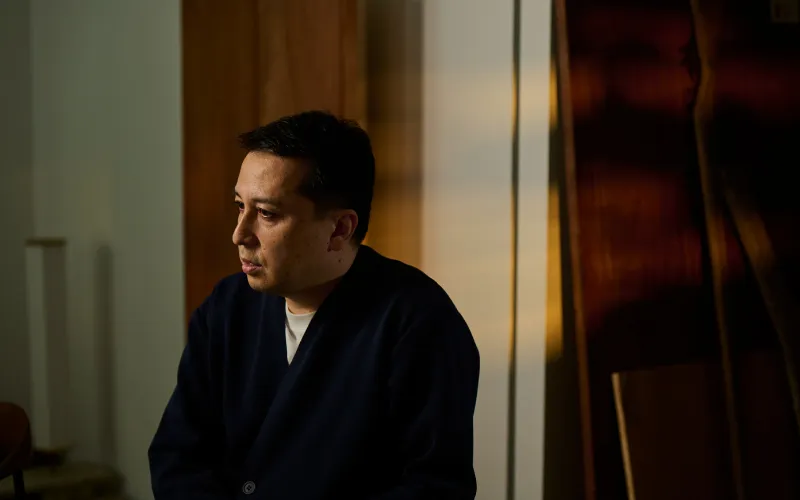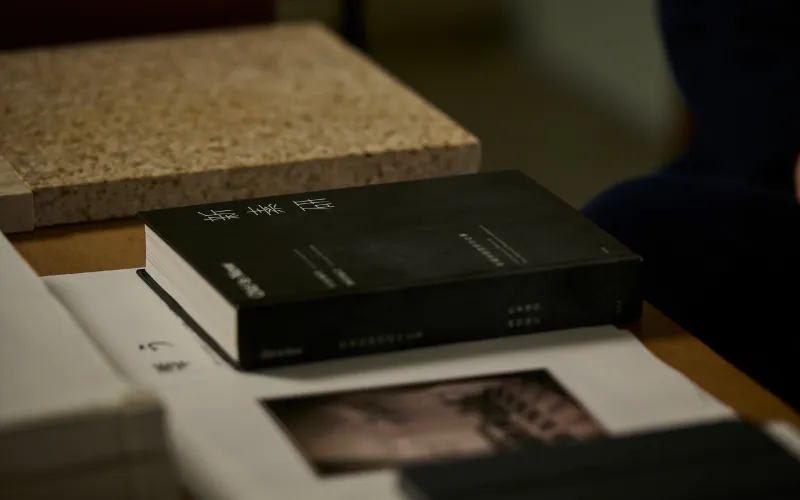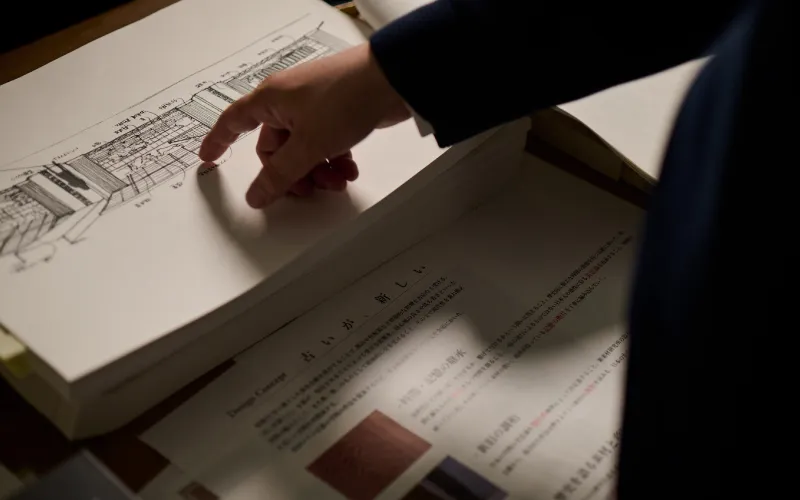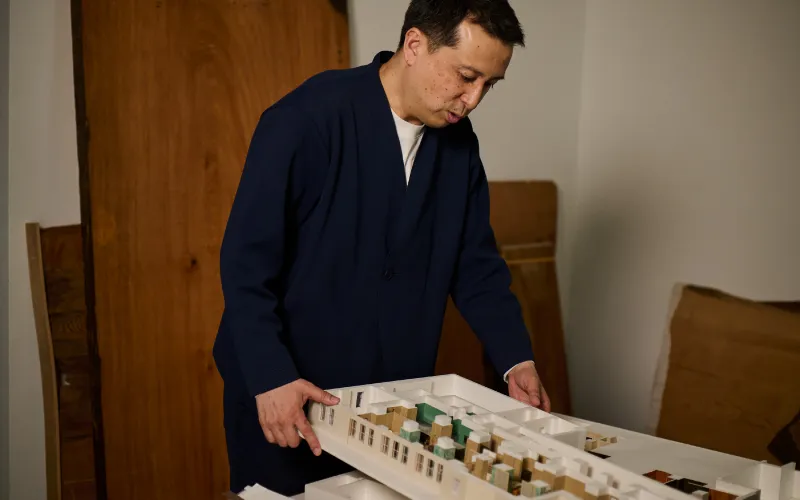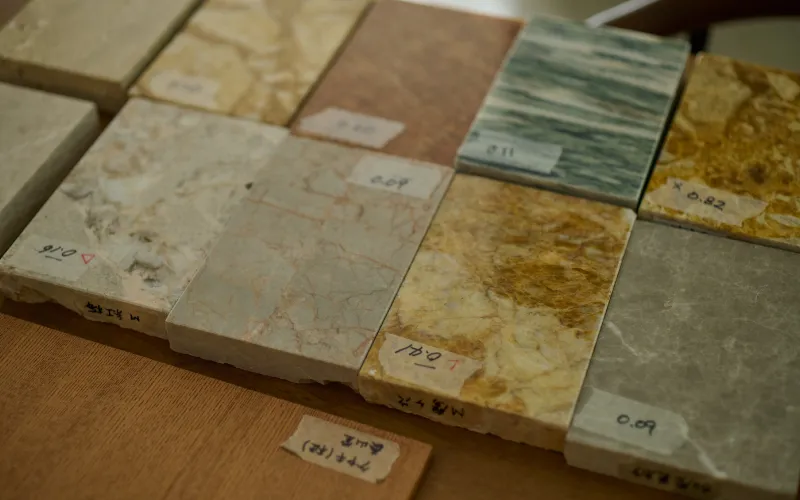Discover the Imperial Hotel, Kyoto - CHAPTER 04 -
Comfort

The Comfort Where the Old is New
The Imperial Hotel, Kyoto, soon to open on the grounds of the historic Gion Kobu Kaburenjo Theater in Kyoto, incorporates and preserves Yasaka Kaikan, the nationally registered tangible cultural property. The interior is being designed by the New Material Research Laboratory, founded by Mr. Tomoyuki Sakakida and Mr. Hiroshi Sugimoto. Renowned for their use of traditional Japanese materials and craftmanship, the firm is creating a space of refined comfort. We spoke with Mr. Sakakida, who is leading the design, about how that vision is being brought to life.
Where Philosophy Meets Place: The New Material Research Laboratory and the Imperial Hotel, Kyoto
Mr. Tomoyuki Sakakida, a native of Shiga Prefecture, has strong ties to Kyoto, having studied architecture at the Graduate School of Kyoto Institute of Technology.
When Imperial Hotel began considering the interior designer for its Kyoto property, the philosophy of ‘Old Is New’ embraced by the New Material Research Laboratory, strongly resonated with the project’s spirit. This project aims to carry forward the legacy of a historic building that has stood as a landmark for the local community and visitors since its completion in 1936, while also creating new cultural resonance. The alignment between the firm’s philosophy and the vision for hotel was seen as a natural and compelling fit.
How did the concept of ‘Old is New’ come about? Mr. Sakakida offered this insight:
"I spent my formative years in Shiga and Kyoto, both places rich in history, so I've always been inclined to see value in what is old. That said, I have also been deeply influenced by Hiroshi Sugimoto, the co-founder of the New Materials Research Laboratory. As a collector of antique art, Sugimoto possesses a profound appreciation for Japan’s historical aesthetics. His creative work often revolves around the theme of ‘time,’ and that sensibility is deeply woven into our design philosophy as well.
Essential to our design philosophy are ‘old materials.’ We seek to shed light on the traditional Japanese building materials and methods that were largely displaced during Japan’s rapid economic growth, and to reinterpret architectural spaces by bringing them back into use. This ethos was encapsulated in our first monograph, published in 2021, titled ‘Old Is New.’ Renovation projects like Wako’s main store in Ginza (Tokyo) and the Odagaki Shoten in Hyogo exemplify this approach.
Since the Industrial Revolution, artistic and cultural shifts such as the Arts and Crafts movement in the UK and the Mingei folk craft movement in Japan have marked a return to hand craftsmanship. Now, more than a century after the advent of modernism, there seems to be a certain sense of stagnation in the air, and a renewed appreciation for the old is taking hold. That, I believe, is why the concept of ‘Old Is New’ is resonating with people.”
Guide by the philosophy of ‘Old Is New,’ three core themes were proposed to shape the design of the Imperial Hotel, Kyoto. These are: ‘The Inheritance of Time and Memory,’ ‘The Harmony and Contrast Between Old and New,’ and ‘Materials and Design That Tell a Story.’
“In a city like Kyoto, layered with centuries of history, the aim was to preserve the beauty of Yasaka Kaikan, completed in 1936, while reinforcing it to endure another hundred or even two hundred years. We sought to pursue a sense of beauty rooted not in fleeting trends, but in the timeless sensibilities of the Japanese aesthetic. We also wanted to thoughtfully weave in fragments of memories of when Yasaka Kaikan was a gathering place for people; this led us to the first theme: ‘The Inheritance of Time and Memory.’
The second theme, ‘Harmony and Contrast Between Old and New’ was inspired by Kyoto’s distinctive cultural landscape, where reverence for the old coexists with an openness to the new. With that in mind, our intention was to give careful attention to refined details while honoring traditional styles.
Lastly, we reflected on what it truly means for a premier Japanese hotel to be born in Kyoto. It therefore felt essential to build the space around Japanese materials. As a side note, the National Diet Building, completed in the same year as Yasaka Kaikan, also makes extensive use of exceptional domestic materials like Japanese marble. It embodies the determination and energy of a time when Japan had to rely solely on its own resources. With that same spirit of craftmanship and historical consciousness informs the third theme: ‘Materials and Design That Tell a Story.’”
A Steady but Inspiring Journey into Their First Hotel Project
Reflecting on the moment his firm was chosen, Mr. Sakakida recalls, “I was truly delighted.”
“Of course, I was pleased that our concept and work aligned with the project’s vision, but I was also deeply moved by the many layers of serendipity. For example, when Frank Lloyd Wright designed the Wright Imperial in 1923, Ōya stone was used extensively for both interior and exterior walls. Since 2020, I’ve served as an ambassador for Ōya stone, promoting the charm and potential uses of Ōya stone to a wide audience. And during my student days, I often wandered through Higashiyama visiting temples and shrines like Kennin-ji Temple and Yasaka Shrine. I would frequently pass by Yasaka Kaikan. Now, after all these years, it feels almost fated that I would find myself involved with that very building.”
And so began the creation of the world for the Imperial Hotel, Kyoto.
This marks the first time that the New Material Research Laboratory has undertaken the interior design of an entire hotel. While they admit to feeling the pressure, Mr. Sakakida describes the process as invigorating and exciting.
“Because we lack preconceived notions about hotel design, we’ve been able to leap over certain conventions quite freely. At the same time, there’s much we’ve had to learn. The project is steadily progressing through thoughtful exchange, among the Imperial Hotel, the on-site artisans, and our team; everyone brings a unique perspective.
What makes this project especially interesting is how vastly different it is in scale from the Imperial Hotel, Tokyo. Whereas Tokyo property has 651 rooms, the Imperial Hotel, Kyoto will have 55. Naturally, the kinds of services possible will differ too, so we need to make a conceptual leap. The team at the Imperial Hotel have a profound dedication to the hotel’s service. In response to their high expectations, we’ve created an abundance of sketches and design proposals.”
From the Five Great Elements to the Five Senses
After many discussions, we decided to place importance on shifting the focus in design from the Five Elements to the Five Senses. The five elements believed to form the basis of all things: sky, wind, fire, water, and earth, serve as the essential materials that shape space. These elements are translated into the space itself, engaging the five senses on a deep, fundamental level.
“What truly defines a space of comfort isn’t just photogenic design,” says Mr. Sakakida. “It’s the subtle presence of these elements in the gentle scent of wood, or the way shikkui plaster, with its natural humidity control, quietly maintains a sense of ease. We believed it was essential to create a space where guests could physically experience these five elements, which are gifts from 4.6 billion years of the Earth’s natural processes. We devoted a great deal of thought to how we composed the materials throughout the design.
The Imperial Hotel, Kyoto’s Role as a Bridge Across Time
Throughout the interior of the hotel, a variety of Japanese stones are featured, including some originally used in Yasaka Kaikan. One of them, known as Tamina-ishi, holds a special story, as Mr. Sakakida recalls.
“I was thrilled when I discovered Tamina-ishi in the former stateroom of Yasaka Kaikan. It’s a stone that was once quarried in Okinoerabu-jima Island in Kagoshima Prefecture. Nearby, I also found a relief depicting the bashō plant, strongly evoking Japan’s former fascination with the South Seas. In fact, the same longing for Okinawan culture can be seen in the Mingei folk craft movement led by Soetsu Yanagi. It stirred in me a sense that placing these elements in a room meant to welcome distinguished guests must have carried some deeper significance. That’s why we are considering using Tamina-ishi boldly in the new hotel, in prominent areas, where it would be seen and appreciated by many.”
This layered intention is part of what Mr. Sakakida believes makes the Imperial Hotel, Kyoto a kind of ‘place that transcends time.’
“Ōya stone, alluding to the identity of the Wright Imperial, and marble, once produced in abundance across Japan during its heyday; these materials and design elements invite visitors to reflect on the grand timeline of history.
Most people tend to think in terms of decades, like spans of 50 or 100 years. But in architecture, the lifecycle extends far beyond that. To contemplate the world through the lens of a millennium is to see our present in an entirely new light. You might picture Murasaki Shikibu gazing at the moon of the Higashiyama hills during the Heian era, and then try to translate that vision into design. The Imperial Hotel, Kyoto is filled with these quiet provocations. I would be delighted if guests can experience the joy of traveling not only through space, but also through time, where uniquely Japanese layers of culture intersect and resonate.”
Discover the Imperial Hotel, Kyoto
Yasaka Kaikan,
once a sanctuary nestled beside the brilliance of Gion's performing arts,
begins a new chapter—revitalized, yet deeply rooted in its legacy.
Set to open in 2026 as the Imperial Hotel, Kyoto,
it welcomes you to a timeless retreat
where comfort takes center stage in every moment you spend.

